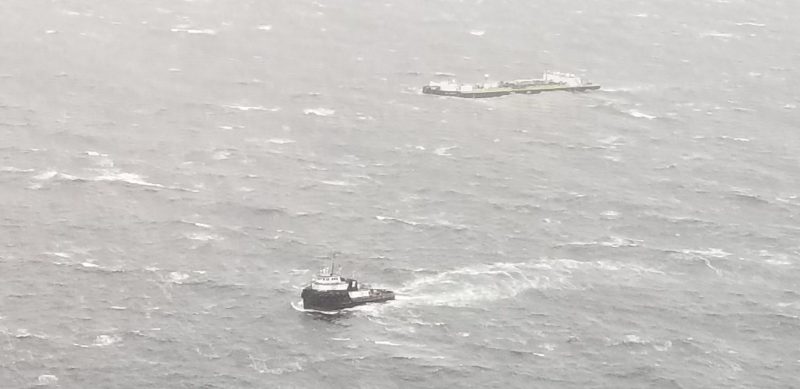An articulated tug and barge carrying 78,000 bbl. of fuel were safely recovered from waters off British Columbia Monday, easing fears of another potential spill not far from the site of a tug sinking a year before.
The Harley Marine Services 111’x36’x17’, 4,070-hp tugboat Jake Shearer and 430’x76’ barge Zidell Marine 277 were northbound Sunday at around 5 p.m. just south of Goose Island when they were struck by “a series of extreme waves hitting the vessels broadside,” causing an alignment problem and separation of the tug and barge, Harley officials said in a statement Monday.
Two crewmembers on the barge safely anchored it about one mile offshore in 200’ of water, as the company and Canadian coast guard organized a response. The 111’x34’x13’, 3,900-hp tug Gulf Cajun was dispatched, and with sea conditions subsided was able to move the barge to safe harbor accompanied by the Jake Shearer and coast guard cutter Gordon Reid.
The Zidell Marine 277 is a double-hulled barge carrying about 67,000 bbl. of diesel and 11,000 bbl. of gasoline. With a total 88,200 bbl. capacity, it was the last barge to be built by Zidell Marine, Portland, Ore., and just launched in June 2017. It was anchored in Norman Morrison Bay along with the Jake Shearer, pending a decision that it is safe for the vessels to link up and proceed.
"Harley Marine is working in cooperation with the Canadian Coast Guard, the Heiltsuk First Nation and provincial and federal government agencies to safely address the incident involving the Jake Shearer and barge. We are committed to successfully resolving this incident," said Capt. Rich Softye, the deputy incident commander for Harley Marine.
The incident alarmed the Heiltsuk and raised worries of a repeat of the 2016 sinking of the 3,400-hp, 95’3”x32’x13’7” tugboat Nathan E. Stewart, operated by Kirby Offshore Marine, which ran aground in heavy weather in the Seaforth Channel, spilling more than 26,000 gals. of its fuel and triggering a 33-day recovery effort.
“It was a sleepless night knowing that the fate of our waters relied on the strength of just a couple of anchor lines holding the barge in place,” Harvey Humchitt, a hereditary chief of the Heiltsuk, said in a statement from the Heiltsuk band government. “This is just one more reminder of why Indigenous first responders should be involved in marine response decision-making right from the start.”
The month-long saga of the Nathan E. Stewart highlighted longstanding calls from First Nation and environmental groups for better protection of the Inside Passage from oil spills and shipping accidents. The Trudeau government pledged more planning and resources for marine environmental response but critics say more can be done.
Two weeks ago the Heiltsuk Nation released a first draft of its proposal an “Indigenous Marine Response Centre” on the central coast.
“During the response to the Nathan E. Stewart, three Liberal cabinet ministers visited Bella Bella promising a world-class spill response that has yet to materialize,” said Marilyn Slett, chief councillor of the Heiltsuk Nation. “The sooner we can all start working together, the safer our coast will be.”
The Heiltsuk proposal calls for a new regional response force to be based on the nation’s territory, “where the majority of incidents on the central coast occur,” staffed by trained crew familiar with the local marine environment, and have vessels and equipment expressly designed for central coast conditions.
With an initial $11 million investment the base operations, fleet, and crew could be in effect by summer 2018, and able to respond to incidents within the designated area in five hours or less, proponents say.




